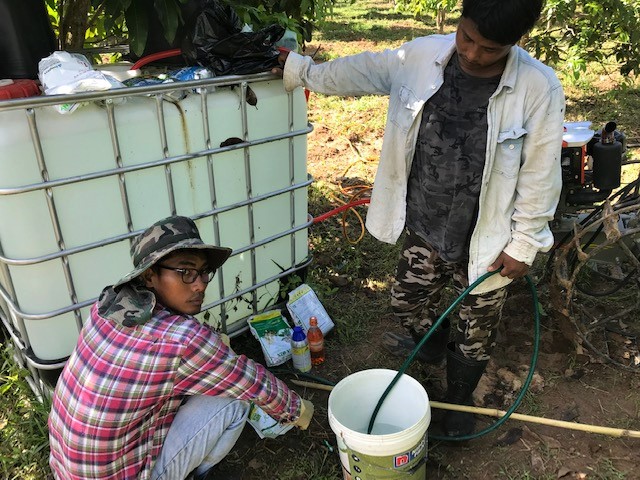The rains have begun and the flowers have sprouted. What will 2022 bring for the mango farmers of Cambodia? Since 2019, the wholesale price for mangoes has been on a steady decline. A new season is met with mixed feelings. With the rising prices of fertilizers and pesticides, transportation, an over-supply of mangoes, and a less demanding market, the future is looking bleak. Mango season Cambodia…it’s going to be one big roller coaster ride!
Unofficially, the Cambodian export market is dominated by Vietnam and Thailand. Thousands of tonnes of mangoes find their way across these borders, to the processing plants of these neighboring countries. From here, they will be cleaned, waxed, and processed, to be then exported to more lucrative markets.
There is a clear chain in the movement of this tropical crop. The farmers are at the bottom, relying only on what the collectors will give them. The collectors are in collaboration with Thai and Vietnam border markets, which in turn, will set the price for the Cambodian mango farmers. The farmers are merely puppets of a larger production show! Mango season Cambodia!

Our Farm – Kep Province
Our farm sits on 1.4 hectares, in the beautiful, fertile province of Kep, with approximately 400 mango trees. We have been there for 6 months already, and have already experienced one harvest. It was not the best season, far from it, but it allowed me to gain an insight into the challenges that mango farmers are facing. We are now in the off-season, June through to November, a more challenging time for the farmers.
We have already sprayed the trees twice. Firstly, to encourage healthy foliage and then secondly, to promote early flowering. As mentioned, we are in the off-season at the moment, hence, lots of rain. With the rain comes the pests. So we will spray again with pesticides, buy more fuel, and the mangoes have not yet even developed. Once the fruit has formed, there will be another series of sprays, to keep the numerous pests away!

So, as you can see, a lot of expenses incurred already. The farmers in the region will be hoping for a better price from the collectors this season, and will hopefully be able to turn a profit!

Mango Season – Mango Logistics
| From | To |
|---|---|
| The Farmers ➡ | The Collectors |
| The Collectors ➡ | Large Collectors/Traders/Wholesalers |
| Wholesalers to Distributers ➡ | Retailers in Phnom Penh/Other Provinces |
| Large Collectors/Traders ➡ | Registered exporters or direct to Thai/Vietnam Unofficially |
| Registered Exporters ➡ | Vietnam/Thailand/China |
The Farmer – Mango Season, Cambodia
The farmers are the mango producers. They are responsible for growing the mango trees and taking care of them until they can be harvested and sold. Keo Romeat mangoes, are the main variety here in Cambodia and can be harvested twice a year, during the on-season from April to May and during the off-season from October through to March. Off-season mangoes fetch higher prices as opposed to on-season mangoes.
Many farmers lease out their mango farms to contractors, hence, to eliminate the risks and expenses incurred. The contractors will manage the whole production. They will purchase the fertilizers and pesticides, pay for fuel, and of course manage the harvest. Contractors will pay anywhere between $3 and $20/tree depending on the age. The contractors will then sell to large collectors or traders for export.
Collectors – Traders – Exporters
When the mangoes are harvested, they are then delivered to the mango co-ops (collectors) for sorting and pricing. Here, they are then graded, to then be sent to larger collectors or traders. Mangoes are generally sorted into 2 grades………
- Large Mangoes – 3 to 4 fruit per kilo, free of blemishes and well colored. These mangoes are considered grade 1.
- Smaller Mangoes – 5 to 6 fruits per kilo with minor defects are considered grade 2.
From here, the collectors will sort them into 25kg plastic crates for export, or, into 25kg bags for local supply.
Wholesalers
The biggest wholesalers are located in Phnom Penh. Mainly Damkor market, where the mangoes are sourced from all over the country. From here they are distributed in 3 different ways…….
- Distributed to retailers and smaller markets in the city.
- Transported to other provinces.
- Exported to other countries.
Exported mangoes predominately end up in Vietnam or Thailand. They find their way over the borders, via registered exporters, or unofficially, via collectors and traders. China had also shown interest in the Cambodian mango market, where the first shipment was sent in May 2021.
Shaky Times Ahead – Cambodia Mango Season
Cambodia’s mango season has been adversely affected by Covid-19. The farmers over-produced and could not find buyers domestically or internationally. It was evident, by seeing piles of mangoes, rotting on the farms and the sides of the roads. By late 2021, the price for in-season mangoes dropped from 50c/kilo to 5c/kilo.
Farmers are now hesitant. The price of fertilizers, pesticides, fuel, and labor defeats the purpose of a good harvest. 2022 will see the farmers mainly grow in the on-season, limit spending on chemicals and only grow for the local market. If they are lucky, they may be able to sell to collectors at more than 5c/kilo. But, not yet to know! The flowers have sprouted and the rains are here…..will it be one BIG ROLLER COASTER, or, something a little more stable? Mango Season Cambodia…… let’s hope for the latter!
Thanks for visiting Mangoes and Mandalas. Check out our other BLOGS here, and follow us on Instagram. Also if you have any more insights into the mango market here in Cambodia, we would love to hear from you in the comments section below!


